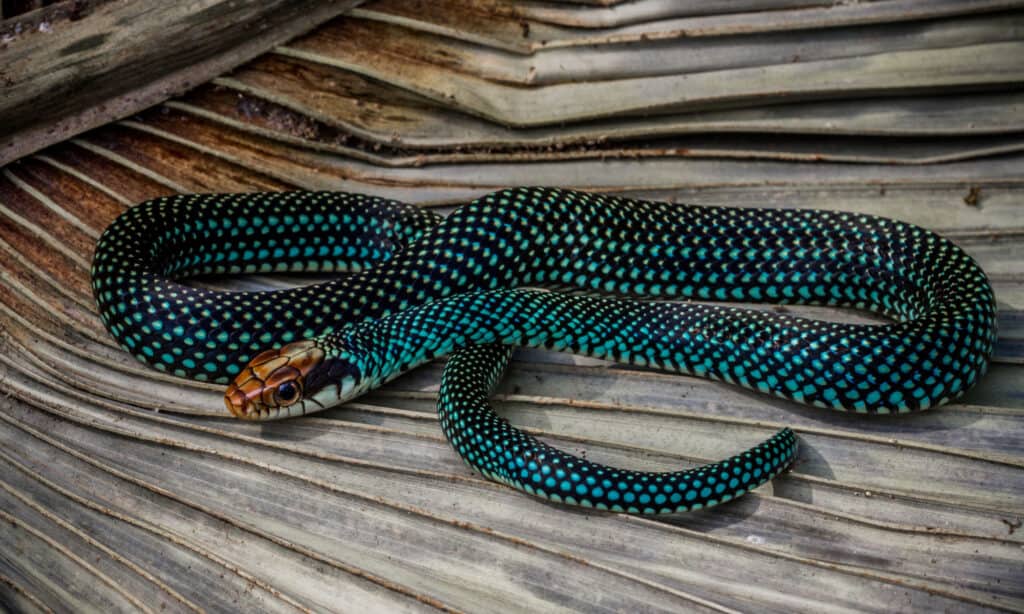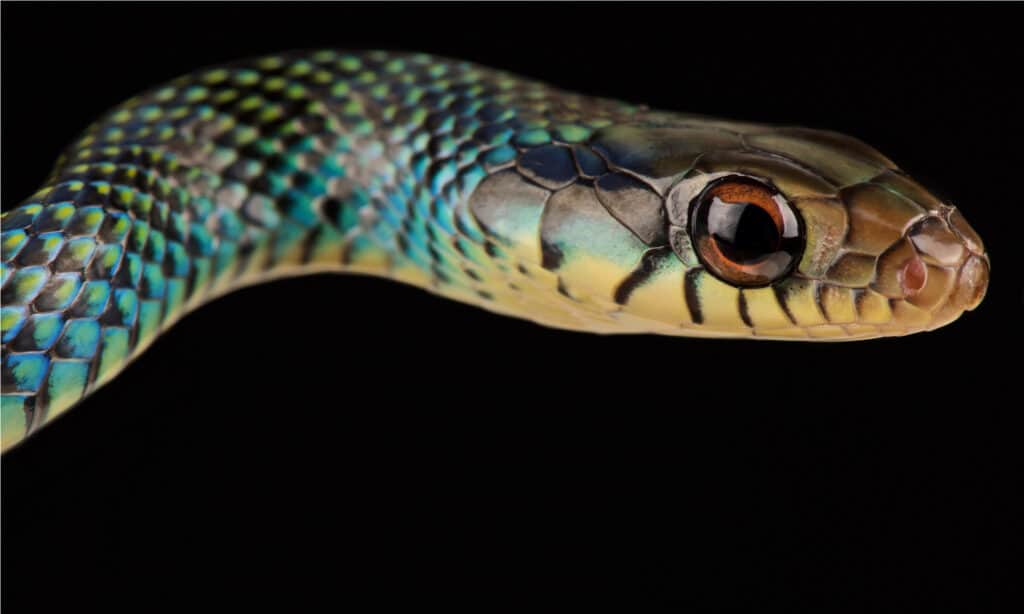Key Points:
- Speckled racers have an average size of about 30-40 inches (76-102 cm) in length. Some can grow over 40 inches.
- Speckled racers inhabit various habitats, including marshlands, savannahs, riparian zones, forest edges and clearings, pastures, and roadsides.
- Speckled racers are predominantly carnivores. They may occasionally prey on reptile eggs, lizards, and other small mammals.
The speckled racer (Drymobius margaritiferus) is a nonvenomous colubrid snake endemic to the Americas. Its specific name, margaritiferus translates to “pearl-bearing” in Latin, which refers to the pearl-like spots on the dorsal scales. As the name “racer” suggests, it’s fast, agile, and primarily a diurnal species. It has been described as a nervous snake that won’t hesitate to bite when threatened. Let’s take a closer look at the largest speckled racer ever found and whether this reptile is dangerous.
How Big is the Largest Speckled Racer Ever Found?

The largest speckled racer specimen ever found measured 50 inches (127 cm) in total length.
©Joe Farah/Shutterstock.com
Speckled racers have an average size of about 30-40 inches (76-102 cm) in length. Some can grow over 40 inches. However, the largest speckled racer specimen ever found measured 50 inches (127 cm) in total length and is still the largest specimen of speckled racer ever recorded up to this day.
What Do Speckled Racers Look Like?
The speckled racer is a medium-sized, relatively slender snake with weakly keeled scales on the upper surface but smooth on the flanks. These scales are arranged in 17 rows. These snakes have a black ground color. They look speckled mainly because of yellow to bluish spotting and one light-colored spot on each scale, which give this snake an overall greenish hue. Its underneath is yellow to green, while its labials are yellow.
Where are Speckled Racers Found?

Speckled racers inhabit various habitats, including marshlands, savannahs, riparian zones, forest edges, and clearings.
©Jakob Pammer/Shutterstock.com
The speckled racer is essentially a Latin American snake whose distribution brings it northward to the very tip of the Sierra Madres of Mexico, up to the east coast of northern Tamaulipas, and up to the west coast of Sonora. This fast-moving, nervous snake is widespread in Belize. It’s also found in South Texas, where it’s currently listed as a threatened species.
Speckled racers inhabit various habitats, including marshlands, savannahs, riparian zones, forest edges and clearings, pastures, and roadsides. Although these snakes have been found in tropical dry forests, they are often thought to prefer wet areas with permanent water sources.
What Do Speckled Racers Eat?
As a diurnal predator, speckled snakes primarily feed on toads and frogs. This explains why they prefer living near water sources. They are predominantly carnivores. They may occasionally prey on reptile eggs, lizards, and other small mammals. Instead of squeezing small prey like a constrictor, speckled snakes typically hold it down so they can swallow it whole. Their jaws exert up to 700 pounds per square inch pressure when feeding.
Do Speckled Racers Have Predators?

Speckled racers are often preyed on by numerous predators, including foxes, coyotes, birds of prey, and other giant snakes.
©reptiles4all/Shutterstock.com
Speckled racers are often preyed on by numerous predators, including foxes, coyotes, birds of prey, and other giant snakes. When confronted by a predator, the speckled racer hisses loudly while puffing out its neck to make itself appear more significant than it really is. If this technique doesn’t work, it will shed its skin while trying to escape to a nearby hiding place like under logs or rocks.
Are Speckled Racers Dangerous?
Specked racers run across human paths pretty frequently because they inhabit agricultural lands. However, these snakes are non-venomous, meaning they are not dangerous to humans. But they are mildly aggressive and will bite in self-defense when restrained or handled. If a speckled racer bites you, clean the wound well enough with warm soapy water to remove any bacteria. Medical attention may not be necessary unless you experience a rare infection or bleeding.
6 Incredible Speckled Racer Facts
While many people can identify a speckled racer, fewer know much about these colorful snakes. Here are some incredible facts to help you distinguish speckled racers from other snakes.
- Speckled racers are diurnal snakes that actively hunt during daylight hours. They have a strong sense of smell to facilitate hunting.
- The average lifespan of speckled racers in captivity is about ten years, but five years in the wild.
- Speckled racers are oviparous, typically laying eggs in spring. Clutch size varies from 2 to 8 eggs, and incubation takes about eight to nine weeks.
- When confronted by a threat, speckled racers will freeze, blend into their surroundings, or bite if cornered.
- The speckled racer has been listed as a threatened species in the state of Texas. It is a common species in some regions of Central America and Mexico.
- There are four recognized subspecies of the speckled racer:
- Northern speckled racer (Drymobius m. margaritiferus)
- Central American speckled racer (Drymobius m. fistulosus)
- Western speckled racer (Drymobius m. occidentalis)
- Drymobius m. maydis
Speckled Racer FAQs (Frequently Asked Questions)
Are speckled racers venomous?
Speckled racers are non-venomous. Although they do not harm humans severely, these snakes can still deliver a painful bite that could lead to allergic reactions or infections. Clean the wound well enough with warm soapy water to remove bacteria in case a speckled racer bites you.
Are speckled racers aggressive?
Speckled racers can seem aggressive out of fear or when feeling threatened. These snakes will not hesitate to bite when restrained or handled.
Where do speckled racers live?
Speckled racers live in the southern regions of the United States, including Texas, Louisiana, and Florida, as well as in South America, Central America, and Mexico. They live in a variety of ecosystems within their range. Some of their favorite habitats include open woodlands, grassland and agricultural areas, and the edges of forests near water sources.
Does a speckled racer make a good pet?
Unlike other species of snakes, speckled racers do not make good pets. They are not remarkably docile animals and rarely become accustomed to handling. In zoological settings, zookeepers handle speckled racers infrequently to reduce stress. Zookeepers keep these snakes in significant habitats because they are very active and do not thrive well in small habitats. Feeding them is pretty simple because they eat small mammals in the wild.
How fast is a speckled racer?
Speckled racers can speed away as fast as 3.5 to 4 mph. Their speed is more effective than their bites. They prefer to use their agility to race away from humans and other threats rather than defend themselves.
The photo featured at the top of this post is © Jakob Pammer/Shutterstock.com
Discover the "Monster" Snake 5X Bigger than an Anaconda
Every day A-Z Animals sends out some of the most incredible facts in the world from our free newsletter. Want to discover the 10 most beautiful snakes in the world, a "snake island" where you're never more than 3 feet from danger, or a "monster" snake 5X larger than an anaconda? Then sign up right now and you'll start receiving our daily newsletter absolutely free.
Thank you for reading! Have some feedback for us? Contact the AZ Animals editorial team.






